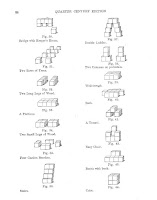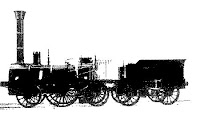 How many blocks is enough? How many different block shapes are enough? How fancy do the blocks need to be?
How many blocks is enough? How many different block shapes are enough? How fancy do the blocks need to be? It often seems that "more is better" is the universal response - eg Legos or Archiquest. Today we look at the other end of the spectrum, and find out that - at times at least - eight blocks, a single shape, and the simplest shape, are enough.
It often seems that "more is better" is the universal response - eg Legos or Archiquest. Today we look at the other end of the spectrum, and find out that - at times at least - eight blocks, a single shape, and the simplest shape, are enough. This is Froebel Gift 3 - part of Friedrich Fröbel's conception of early childhood education, which he called "Kindergarten" and introduced to worldwide acclaim.
This is Froebel Gift 3 - part of Friedrich Fröbel's conception of early childhood education, which he called "Kindergarten" and introduced to worldwide acclaim.The Gifts were intended to be given to children as educational toys, were very carefully designed, and were supported with well-explained lesson plans.
 Following the first Gift of six soft balls in different colors and the second gift of three important shapes, Froebel's Third Gift introduced block play with eight 1" cubes of wood fitted into a cubical wooden box, to demonstrate breaking up into parts and reassembly in the same and different forms.
Following the first Gift of six soft balls in different colors and the second gift of three important shapes, Froebel's Third Gift introduced block play with eight 1" cubes of wood fitted into a cubical wooden box, to demonstrate breaking up into parts and reassembly in the same and different forms. Unfortunately, too many of Froebel's followers were too worshipful, too unimaginative, too rigid, and missed major points of his teachings entirely, and instead followed examples in the plethora of Froebelian books as if they were gospel. Froebel's approach fell from favor, and teh Kindergarten movement sought new directions.
Unfortunately, too many of Froebel's followers were too worshipful, too unimaginative, too rigid, and missed major points of his teachings entirely, and instead followed examples in the plethora of Froebelian books as if they were gospel. Froebel's approach fell from favor, and teh Kindergarten movement sought new directions. The banishment even extended to the blocks which make up his instructional tools in Gifts 3 through 6 (the later gifts introduced more complex educational play - including the precursor of Tinkertoys, and hence K'nex et al). They were to be replaced by Carolyn Pratt's enlarged Kindergarten Blocks or Unit Blocks, based on the rectangular blocks of Froebel Gift 4 and Gift 6.
The banishment even extended to the blocks which make up his instructional tools in Gifts 3 through 6 (the later gifts introduced more complex educational play - including the precursor of Tinkertoys, and hence K'nex et al). They were to be replaced by Carolyn Pratt's enlarged Kindergarten Blocks or Unit Blocks, based on the rectangular blocks of Froebel Gift 4 and Gift 6. Admittedly, the rectangular blocks do make for better play, and some of the smaller blocks of Gift 5 present real problems, but there is still something important that can be gained by a block builder spending some Block Play time with the eight cubes of Gift 3.
Admittedly, the rectangular blocks do make for better play, and some of the smaller blocks of Gift 5 present real problems, but there is still something important that can be gained by a block builder spending some Block Play time with the eight cubes of Gift 3. Click on the small scans here, from one of the last of the books of the Froebel Kindergarten era, and you can print out larger scans of kind of designs that appeared in ever-increasing numbers in book after book. If you get caught up in them to the exclusion of exploring your own designs, you may be a rigid Freobelian at heart, or you may be like me and just enjoying the therapeutic aspects.
Click on the small scans here, from one of the last of the books of the Froebel Kindergarten era, and you can print out larger scans of kind of designs that appeared in ever-increasing numbers in book after book. If you get caught up in them to the exclusion of exploring your own designs, you may be a rigid Freobelian at heart, or you may be like me and just enjoying the therapeutic aspects. Fortunately, Froebel Gifts are still (or again) available from different sources - even Ankerstein, whose popular stone blocks get their start as a development of Froebel Blocks, has a set in their composite artifical stone.
Fortunately, Froebel Gifts are still (or again) available from different sources - even Ankerstein, whose popular stone blocks get their start as a development of Froebel Blocks, has a set in their composite artifical stone. Many of the designs were passed forward from book to book, and were quite quaint by the end of the era- the locomotive here, and several other topics, was about as unrecognizable in 1907 as 2009 to Americans unfamiliar with early 19th century Germany.
Many of the designs were passed forward from book to book, and were quite quaint by the end of the era- the locomotive here, and several other topics, was about as unrecognizable in 1907 as 2009 to Americans unfamiliar with early 19th century Germany. For a bit of a digression, I have been admiring, but not quite buying, Stönees rock-shaped building "blocks," and it occurred to me that it might be fun to select eight of the more cubish (of a single color, for me), and see how many of the Froebel Gift 3 construction one could build. My previous Gift 3 post showed that I am not too rigid in what I use, at least.
For a bit of a digression, I have been admiring, but not quite buying, Stönees rock-shaped building "blocks," and it occurred to me that it might be fun to select eight of the more cubish (of a single color, for me), and see how many of the Froebel Gift 3 construction one could build. My previous Gift 3 post showed that I am not too rigid in what I use, at least.I expect Stönees to deliver - just as Froebel Gifts long have - Good Block Play.




2 comments:
You'll have to let me know about those Stones. They look like a real nice product. Being made in Canada makes me want to buy them. Go Canada!
I also liked the discussion on Froebel blocks.
Canada?
Isn't that somewhere north of Cleveland?
:)
I'd like to see what you could do with a bunch of Stönees and your creative Ankerstein-trained mindset.
Post a Comment